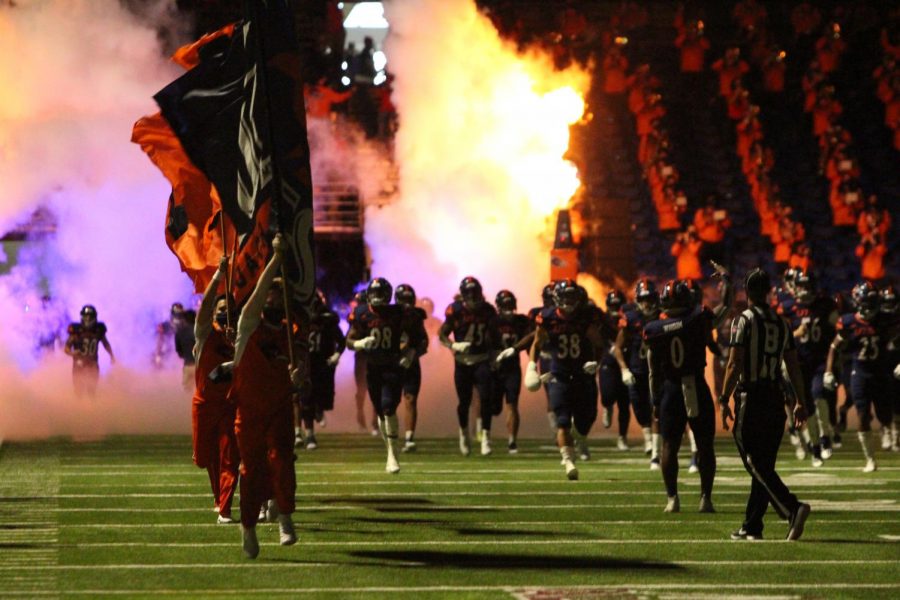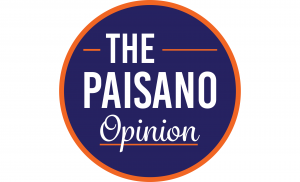The AP top 25 needs to change, here’s how
October 20, 2020
The Associated Press (AP) Top 25 is broken. Long the hallmark for measuring and ranking the best teams in college football, the AP Top 25 has been in use since 1936. While the AP Poll has been passed in importance in college football since the institution of first the Bowl Championship Series (BCS) rankings in 1998, followed by the College Football Playoff in 2014, it still serves as an important touchstone in college football, helping to guide more casual fans on who the best teams in the nation are. However, the AP Top 25 is broken, and it has been for a long time now. There are a number of reasons why, and there are a number of things that need to be remedied.
For starters, let’s look at the biggest aspect of the AP Top 25 that needs to be reformed, the preseason rankings. First used by the AP Poll in 1950, they rank the 25 best teams in the nation before the season starts. This is a problem; the only way the AP Poll is able to rank these teams is off of past performance and how teams stack up to their competition on paper. This approach is inherently flawed for a number of reasons. First off, games are not played on paper, they are played on the field, so this approach is always going to favor the blue blood programs, those that are traditional college football powerhouses who have access to the best recruits. As we have seen time after time, however, the best recruits do not guarantee great results on the field. The University of Texas, for example, is always rated highly in the preseason top 25, but consistently in the past decade they have fallen well short of expectations and underperformed on the field. What consistently saves programs like Texas, however, is the preseason top 25 and prior success. With that on their side, programs ranked in the preseason top 25 have a safety net to absorb bad losses. Take for example Louisiana State University (LSU) this year — the defending national champions started the year ranked 6th in the preseason top 25, due to their success last year, and the amount of talent they have on their roster. Through their first three games of the season, however, it is clear that this LSU team is nowhere near as good on the field as last year’s team and will struggle to stay above .500. Despite this, however, it is likely that teams that have defeated LSU will earn some brownie points for the win, just because LSU was ranked in the preseason top 25. What AP fails to consider is how much can happen to a program over a single offseason. UTSA is a more recent example, adding an entire new arsenal of coaches and recruiters since last season. Entire programs can be dismantled and rebuilt between seasons, and evaluating last year’s UTSA team versus this year’s team, you would be comparing two drastically different programs.
In addition, preseason ranking usually gives a team an advantage over teams that do not start the year in that poll. Texas A&M is a great example of a team that is consistently ranked highly in the first preseason poll and then fumbles it away due to inconsistency, leading to a habitual 8-5 record that will always see them sneak their way into the top 25 at the end of the season. This is despite having a record that would not indicate they are one of the 25 best teams in the country. The biggest fix for this issue would be to get rid of the preseason top 25. To rank teams before even seeing them on the field is flawed on a very basic level and will always favor teams that have excelled in recruitment, but have not necessarily been able to translate that to success on the field. Instead the AP Poll should hold off on ranking any teams until after week four of the season. Four weeks is more than enough time to begin to get a sense of how these teams actually look for this season, thus removing the issue of determining who the best teams are on paper before the season begins, and then having that affect the rankings from then onwards.
The next issue with the AP Top 25 is emphasis on conference placement. A school that belongs to the Southeastern Conference (SEC) in particular is going to have an implicit advantage in the rankings over teams from other conferences. Teams in the SEC have consistently been rewarded in the AP Top 25 for often middling performances throughout the year, while teams in conferences with less prestige, such as the American Athletic Conference, the Mountain West Conference, or even a bigger power five conference like the PAC 12, have to consistently claw their way into the rankings. While it can be pointed out that the SEC has some strong teams like Alabama and Georgia, that does not excuse the rest of the conference’s mediocrity in most seasons.
Despite this, however, because of the mirage of the conference’s “prestige,” average SEC teams are frequently rewarded for average wins over other SEC teams. Teams like the University of Central Florida (UCF), the University of Cincinnati and Boise State University, year after year, have to start from square one and trudge their way up from either a low starting point in the top 25 or entirely out of it, passing the same mediocre Power 5 conference teams that underperform every season, yet magically find themselves back in the rankings the following season. Enough is enough, it is time to take the supposed “prestige” of a conference out of the decision-making in ranking the top 25. Evaluate each team based on who they are playing. If the SEC has a down year, make sure to take that into account, if it is clear that the teams UCF or Cincinnati are playing are struggling take that into account. Giving free passes to teams just because of the conference they play in must end.
In an effort to better understand the seemingly broken ranking system, one should consider who exactly is voting. A panel of 62 sports writers each cast a weekly vote, that then is the deciding factor as to who ranks where. This method of voting is flawed for two reasons: Bias in the sample being polled could potentially lead to a weekly poll that is not representative of a team’s overall performance that week. Also games that are considered “guaranteed” wins for major programs, due to that major program funneling cash to inferior teams in an effort to boost their win record can make a big program look dominant when they just played a far less talented program. The SEC and Big Ten are notorious for paying big to host smaller programs. A 2014 article by ESPN Senior Writer Darren Rovell cited that teams like the University of Florida and the University of Michigan contributed to the $12.9 million paid to smaller programs over a single week of play. Michigan paid Appalachian State University $1 million to play them that same season. LSU’s contract to play UTSA and Nicholls State University this season totaled $2.4 million to the two schools combined. LSU, the reigning champions of College Football, along with other powerhouse programs make it to the top of the ranks by playing bad schools, further taking away credibility of polling data.
Finally, to underscore the points already made, a new aspect of how the AP Top 25 is broken has appeared this season due to the COVID-19 pandemic. The appearance of teams in the top 25 that have yet to play a game five weeks into the season is a travesty and reeks of favoritism shown towards the elite of college football. The fact that teams such as Ohio State University and the University of Oregon, who will not start their seasons until late October and November respectively, have appeared in the top 25 in the last three weeks is insulting to teams that have already started their schedule. The top 25 can be a big achievement for smaller programs that have worked hard to get to this point. Smaller schools from smaller conferences must work twice as hard as their power five conference brethren. UTSA for example, has never appeared in the top 25 and only received votes to do so for the first time ever following their week two win over Stephen F. Austin State University. Those votes were promptly lost after the BIG 10 and PAC 12 announced a reversal of fall football cancellations and a return to play. Schools from those conferences were promptly reinserted back into the top 25. To teams that have already put in the work, this is, again, a slap in the face.
Teams who have yet to prove themselves, teams that are coasting on reputation, are rewarded for just announcing that they will be playing football. It is more likely than not that a team like Ohio St. or Oregon are among the best 25 teams in all of college football, but they should earn it. Teams that have yet to play games should have no right to be ranked in anything. UTSA was the first team in the Nation to be 3-0 on the season, not to mention being led by the nation’s leading rusher in Sincere McCormick. Although the UTSA program is not composed of four and five star recruits, being able to put up accolades against true competition should have earned UTSA more than two votes. Productivity is too much of a central theme in college football to play so small of a role in how rankings are constructed.
The AP Top 25 is broken, but it does not have to be that way. An elimination of preseason rankings, conference bias and especially the practice of ranking teams who have yet to play could see the AP Top 25 return to respectability and objectivity. Small programs in small conferences will continue to remain at the bottom as long as the AP Top 25 stays stagnant. UTSA was the first team in the country to earn 3 wins and they were not even placed in the top 50 among schools who tallied up at least one loss for the year. The AP Top 25 holds the power to make college football enjoyable and unpredictable, but the implicit bias within the rankings only hinders the growth of programs who have still yet to see the spotlight.











